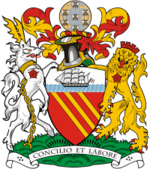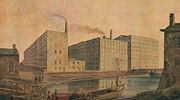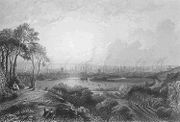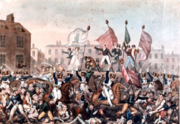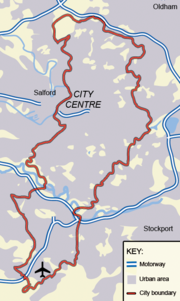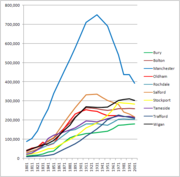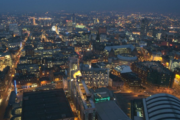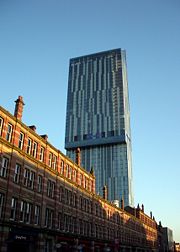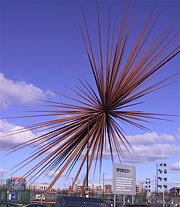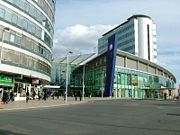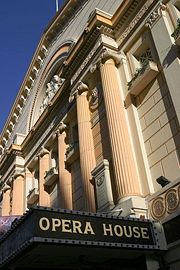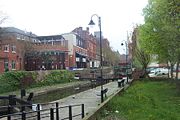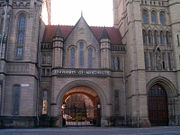Manchester
2008/9 Schools Wikipedia Selection. Related subjects: British Cities; Great Britain
| City of Manchester | |||
| Manchester skyline from the River Irwell | |||
|
|||
| Nickname: "Capital of the North", " Cottonopolis", " Second city", "Warehouse City" | |||
| Motto: "Concilio Et Labore" "Wisdom and effort" | |||
| Manchester shown within England | |||
| Coordinates: | |||
|---|---|---|---|
| Sovereign state | United Kingdom | ||
| Constituent country | England | ||
| Region | North West England | ||
| Ceremonial county | Greater Manchester | ||
| Admin HQ | Manchester City Centre | ||
| Founded | 1st century | ||
| Town charter | 1301 | ||
| City status | 1853 | ||
| Government | |||
| - Type | Metropolitan borough, City | ||
| - Governing body | Manchester City Council | ||
| - Lord Mayor | Glynn Evans | ||
| - MPs: | Paul Goggins (L) Sir Gerald Kaufman (L) John Leech (LD) Tony Lloyd (L) Graham Stringer (L) |
||
| Area | |||
| - Borough & City | 44.7 sq mi (115.65 km²) | ||
| Elevation | 256 ft (78 m) | ||
| Population (2006 est.) | |||
| - Borough & City | 452,000 ( Ranked 5th) | ||
| - Density | 9,880.8/sq mi (3,815/km²) | ||
| - Urban | 2,240,230 ( Greater Manchester Urban Area) |
||
| - Metro | 4,209,132 | ||
| - County | 2,547,700 | ||
| - County Density | 5,172.2/sq mi (1,997/km²) | ||
| - Ethnicity ( 2005 Estimates) |
77.6% White 71.0% White British 3.0% White Irish 3.6% Other White 3.2% Mixed 1.3% White & Black Caribbean 0.6% White & Black African 0.7% White & South Asian 0.7% White & Other 10.3% South Asian 2.3% Indian 5.8% Pakistani 1.0% Bangladeshi 1.2% Other South Asian 5.2% Black 2.0% Black Carribean 2.7% Black African 0.5% Other Black 3.7% East Asian and Other 2.3% Chinese 1.4% Other |
||
| Time zone | Greenwich Mean Time ( UTC+0) | ||
| Postcode | M | ||
| Area code(s) | 0161 | ||
| ISO 3166-2 | GB-MAN | ||
| ONS code | 00BN | ||
| OS grid reference | SJ838980 | ||
| NUTS 3 | UKD31 | ||
| Website: www.manchester.gov.uk | |||
Manchester ( pronunciation ; pronounced /ˈmæntʃɛstə/) is a city and metropolitan borough of Greater Manchester, England. Manchester was granted city status in 1853. It has a population of 452,000, and lies at the centre of the wider Greater Manchester Urban Area, which has a population of 2,240,230, the United Kingdom's third largest conurbation. Manchester has the second largest urban zone in the UK and the fourteenth most populated in Europe.
Forming part of the English Core Cities Group, often described as the second city of the UK, and the "Capital of the North", Manchester today is a centre of the arts, the media, higher education and commerce. In a poll of British business leaders published in 2006, Manchester was regarded as the best place in the UK to locate a business. A report commissioned by Manchester Partnership, published in 2007, showed Manchester to be the "fastest-growing city" economically. It is the third most visited city in the United Kingdom by foreign visitors. Manchester was the host of the 2002 Commonwealth Games, and among its other sporting connections are its two Premier League football teams, Manchester United and Manchester City.
Historically, most of the city was a part of Lancashire, with areas south of the River Mersey being in Cheshire. Manchester was the world's first industrialised city and played a central role during the Industrial Revolution. It was the dominant international centre of textile manufacture and cotton spinning. During the 19th century it acquired the nickname Cottonopolis, suggesting it was a metropolis of cotton mills. Manchester City Centre is now on a tentative list of UNESCO World Heritage Sites, mainly due to the network of canals and mills constructed during its 19th-century development.
History
Toponymy
The name Manchester originates from the Ancient Roman name Mamucium, thought to be a Latinisation of an original Celtic name (possibly meaning "breast-like hill" from mamm- = "breast"), plus Anglo-Saxon ceaster = "town", which is derived from Latin castra = "camp". Manchester is also the 10th most common place name in the United States.
Early history
The Brigantes were the major Celtic tribe of what is now Northern England whom had a stronghold in the locality at a sandstone outcrop on which Manchester Cathedral now stands, opposite the banks of the River Irwell. Their territory extended across the fertile lowland of what is now Salford and Stretford. Following the Roman conquest of Britain in the 1st century, General Agricola ordered the construction of a Roman fort in the year 79 named Mamucium to ensure Roman interests with Deva Victrix ( Chester) and Eboracum (York) were protected from the Brigantes. Central Manchester has been permanently settled since this time. A stabilised fragment of foundations of the final version of the Roman fort is visible in Castlefield. The Romans withdrew in the early 5th century, and by the time of the Norman Conquest in 1066 the focus of settlement had shifted to the confluence of the rivers Irwell and Irk. Much of the wider area was laid waste in the subsequent Harrying of the North.
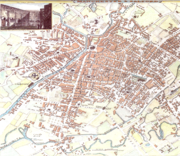
Thomas de la Warre, lord of the manor, founded and constructed a collegiate church for the parish in 1421. The church is now Manchester Cathedral; the domestic premises of the college now house Chetham's School of Music and Chetham's Library.
Around the 14th century, Manchester received an influx of Flemish weavers, sometimes credited as the foundation of the region's textile industry. Manchester became an important centre for the manufacture and trade of woollens and linen, and by about 1540, had expanded to become, in John Leland's words, "The fairest, best builded, quickest, and most populous town of all Lancashire." The cathedral and Chetham's buildings are the only significant survivors of Leland's Manchester.
During the English Civil War, Manchester strongly favoured the Parliamentary interest. Although not long lasting, Cromwell granted it the right to elect its own MP. Charles Worsley, who sat for the city for only a year, was later appointed Major General for Lancashire, Cheshire and Staffordshire during the Rule of the Major Generals. He was a diligent puritan, turning out ale houses and banning the celebration of Christmas; he died in 1656.
Significant quantities of cotton began to be used after about 1600, firstly in linen/cotton fustians, but by around 1750 pure cotton fabrics were being produced and cotton had overtaken wool in importance. The Irwell and Mersey were made navigable by 1736, opening a route from Manchester to the sea docks on the Mersey. The Bridgewater Canal, Britain's first wholly artificial waterway, was opened in 1761, bringing coal from mines at Worsley to central Manchester. The canal was extended to the Mersey at Runcorn by 1776. The combination of competition and improved efficiency halved the cost of coal and halved the transport cost of raw cotton. Manchester became the dominant marketplace for textiles produced in the surrounding towns. A commodities exchange, opened in 1729, and numerous large warehouses, aided commerce.
In 1780, Richard Arkwright began construction of Manchester's first cotton mill.
Industrial Revolution
Much of Manchester's history is concerned with textile manufacture during the Industrial Revolution. The great majority of cotton spinning took place in the towns of south Lancashire and north Cheshire, and Manchester was for a time the most productive centre of cotton processing, and later the world's largest marketplace for cotton goods. Manchester was dubbed " Cottonopolis" and "Warehouse City" during the Victorian era.
Manchester began expanding "at an astonishing rate" around the turn of the 19th century as part of a process of unplanned urbanisation brought on by the Industrial Revolution. It developed a wide range of industries, so that by 1835 "Manchester was without challenge the first and greatest industrial city in the world." Engineering firms initially made machines for the cotton trade, but diversified into general manufacture. Similarly, the chemical industry started by producing bleaches and dyes, but expanded into other areas. Commerce was supported by financial service industries such as banking and insurance. Trade, and feeding the growing population, required a large transport and distribution infrastructure: the canal system was extended, and Manchester became one end of the world's first intercity passenger railway—the Liverpool and Manchester Railway. Competition between the various forms of transport kept costs down. In 1878 the GPO (the forerunner of British Telecom) provided its first telephones to a firm in Manchester.
The Manchester Ship Canal was created by canalisation of the Rivers Irwell and Mersey for 36 miles (58 km) from Salford to the Mersey estuary. This enabled ocean going ships to sail right into the Port of Manchester. On the canal's banks, just outside the borough, the world's first industrial estate was created at Trafford Park. Large quantities of machinery, including cotton processing plant, were exported around the world.
A centre of capitalism, Manchester was frequented by bread and labour riots, as well as calls for greater political recognition by the city's working and non-titled classes, most famously on St Peter's Field on 16 August 1819, known as Peterloo. Manchester was the subject of Friedrich Engels' The Condition of the Working Class in England in 1844; Engels himself spent much of his life in and around Manchester. The first Trades Union Congress was held in Manchester (at the Mechanics' Institute, David Street), from 2 to 6 June 1868. Manchester was also an important cradle of the Labour Party and the Suffragette Movement.
At that time, it seemed a place in which anything could happen—new industrial processes, new ways of thinking (the Manchester School, promoting free trade and laissez-faire), new classes or groups in society, new religious sects, and new forms of labour organisation. It attracted educated visitors from all parts of Britain and Europe. A saying capturing this sense of innovation survives today: "What Manchester does today, the rest of the world does tomorrow." Manchester's golden age was perhaps the last quarter of the 19th century. Many of the great public buildings (including the Town Hall) date from then. The city's cosmopolitan atmosphere contributed to a vibrant culture, which included the Hallé Orchestra. In 1889, when county councils were created in England, the municipal borough became a county borough with even greater autonomy.
Although the Industrial Revolution brought wealth to the city, it also brought poverty and squalor to a large part of the population. Historian Simon Schama noted that "Manchester was the very best and the very worst taken to terrifying extremes, a new kind of city in the world; the chimneys of industrial suburbs greeting you with columns of smoke". An American visitor taken to Manchester’s blackspots saw “wretched, defrauded, oppressed, crushed human nature, lying and bleeding fragments”.
The number of cotton mills in Manchester itself reached a peak of 108 in 1853. Thereafter the number began to decline and Manchester was surpassed as the largest centre of cotton spinning by Bolton in the 1850s and Oldham in the 1860s. However, this period of decline coincided with the rise of city as the financial centre of the region. Manchester continued to process cotton, and in 1913, 65% of the world's cotton was processed in the area. The First World War interrupted access to the export markets. Cotton processing in other parts of the world increased, often on machines produced in Manchester. Manchester suffered greatly from the Great Depression and the underlying structural changes that began to supplant the old industries, including textile manufacture.
World War II
Like most of the UK, the Manchester area mobilised extensively during World War II. For example, casting and machining expertise at Beyer, Peacock and Company's locomotive works in Gorton was switched to bomb making; Dunlop's rubber works in Chorlton-on-Medlock made barrage balloons; and just outside the city in Trafford Park, engineers Metropolitan-Vickers made Avro Manchester and Avro Lancaster bombers and Ford built the Rolls-Royce Merlin engines to power them. Manchester was thus the target of bombing by the Luftwaffe, and by late 1940 air raids were taking place against non-military targets. The biggest took place during the " Christmas Blitz" on the nights of 22/23 and 23/24 December 1940, when an estimated 467 tons (475 tonnes) of high explosives plus over 37,000 incendiary bombs were dropped. A large part of the historic city centre was destroyed, including 165 warehouses, 200 business premises, and 150 offices. 376 were killed and 30,000 houses were damaged. Manchester Cathedral was among the buildings seriously damaged; its restoration took 20 years.
Cotton processing and trading continued to fall in peacetime, and the exchange closed in 1968. By 1963 the port of Manchester was the UK's third largest, and employed over 3,000 men, but the canal was unable to handle the increasingly large container ships. Traffic declined, and the port closed in 1982. Heavy industry suffered a downturn from the 1960s and was greatly reduced during the economic reforms associated with Margaret Thatcher's government (i.e. 1979 onwards). Manchester lost 150,000 jobs in manufacturing between 1961 and 1983.
Regeneration began in the late 1980s, with initiatives such as the Metrolink, the Bridgewater Concert Hall, the Manchester Evening News Arena, and (in Salford) the rebranding of the port as Salford Quays. Two bids to host the Olympic Games were part of a process to raise the international profile of the city.
1996 bomb
Manchester has a history of attacks attributed to Irish Republicans, including the Manchester Martyrs of 1867, arson in 1920, a series of explosions in 1939, and two bombs in 1992. On Saturday 15 June 1996, the Provisional Irish Republican Army (IRA) detonated a large bomb next to a department store in the city centre. The largest to be detonated on British soil, the bomb injured over 200 people, heavily damaged nearby buildings, and broke windows half a mile away. The cost of the immediate damage was initially estimated at £50 million, but this was quickly revised upwards. The final insurance payout was over £400 million; many affected businesses never recovered from the loss of trade.
Redevelopment
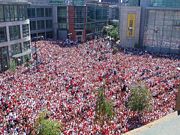
Spurred by the investment after the 1996 bomb, and aided by the XVII Commonwealth Games, Manchester's city centre has undergone extensive regeneration. New and renovated complexes such as The Printworks and the Triangle have become popular shopping and entertainment destinations. The Manchester Arndale is the UK's largest city centre shopping mall.
Large sections of the city dating from the 1960s have been either demolished and re-developed or modernised with the use of glass and steel. Old mills have been converted into modern apartments, Hulme has undergone extensive regeneration programmes, and million-pound lofthouse apartments have since been developed. The 169-metre tall, 47-storey Beetham Tower, completed in 2006, is the tallest building in the UK outside London and the highest residential accommodation in western Europe. The lower 23 floors form the Hilton Hotel, featuring a "sky bar" on the 23rd floor. Its upper 24 floors are apartments. In January 2007, the independent Casino Advisory Panel awarded Manchester a licence to build the only supercasino in the UK to regenerate the Eastlands area of the city, but in March the House of Lords rejected the decision by three votes rendering previous House of Commons acceptance meaningless. This left the supercasino, and 14 other smaller concessions, in parliamentary limbo until a final decision was made. On 11 July 2007, a source close to the government declared the entire supercasino project "dead in the water". A member of the Manchester Chamber of Commerce professed himself "amazed and a bit shocked" and that "there has been an awful lot of time and money wasted". After a meeting with the Prime Minister, Manchester City Council issued a press release on 24 July 2007 stating that "contrary to some reports the door is not closed to a regional casino". The supercasino was officially declared dead in February 2008 with a compensation package described by the media as "rehashed plans, spin and empty promises."
Second City
Manchester has recently been regarded by the international press, British public, and government ministers as being the second city of the United Kingdom. A 2007 poll by the BBC placed it ahead of Birmingham and Liverpool in the category of second city of England, but also ahead in the category of third city. Neither categories are officially sanctioned, and criteria for determining what 'second city' means are ill-defined. Manchester is not the second largest city in size or population, but it is argued that cultural and historical criteria are more important. The BBC reports that redevelopment of recent years has heightened claims that Manchester is the second city of the UK. This title however, which is unofficial in the UK, has traditionally been held by Birmingham since the early 20th century.
Governance
Manchester is represented by three tiers of government, Manchester City Council ("local"), UK Parliament ("national"), and European Parliament ("Europe"). Greater Manchester County Council administration was abolished in 1986, and so the city council is effectively a unitary authority. Since its inception in 1995, Manchester has been a member of the English Core Cities Group, which, amongst other things, serves to promote the social, cultural and economic status of the city at an international level.
The town of Manchester was granted a charter by Thomas Grelley in 1301 but lost its borough status in a court case of 1359. Until the 19th century, local government was largely provided by manorial courts, the last of which ended in 1846. From a very early time, the township of Manchester lay within the historic county boundaries of Lancashire. Pevsner wrote "That [neighbouring] Stretford and Salford are not administratively one with Manchester is one of the most curious anomalies of England". A stroke of a Norman baron's pen is said to have divorced Manchester and Salford, though it was not Salford that became separated from Manchester, it was Manchester, with its humbler line of lords, that was separated from Salford. It was this separation that resulted in Salford becoming the judicial seat of Salfordshire, which included the ancient parish of Manchester. Manchester later formed its own Poor Law Union by the name of Manchester. In 1792, commissioners—usually known as police commissioners—were established for the social improvement of Manchester. In 1838, Manchester regained its borough status, and comprised the townships of Beswick, Cheetham Hill, Chorlton upon Medlock and Hulme. By 1846 the borough council had taken over the powers of the police commissioners. In 1853 Manchester was granted city status in the United Kingdom.
In 1885, Bradford, Harpurhey, Rusholme and parts of Moss Side and Withington townships became part of the City of Manchester. In 1889, the city became the county borough of Manchester, separate from the administrative county of Lancashire, and thus not governed by Lancashire County Council. Between 1890 and 1933, more areas were added to the city from Lancashire, including former villages such as Burnage, Chorlton-cum-Hardy, Didsbury, Fallowfield, Levenshulme, Longsight, and Withington. In 1931 the Cheshire civil parishes of Baguley, Northenden and Northern Etchells from the south of the River Mersey were added. In 1974, by way of the Local Government Act 1972, the City of Manchester became a metropolitan district of the metropolitan county of Greater Manchester. That year, Ringway, the town where Manchester Airport is located, was added to the city.
Geography
| Climate chart for Manchester | |||||||||||
|---|---|---|---|---|---|---|---|---|---|---|---|
| J | F | M | A | M | J | J | A | S | O | N | D |
|
69
6
1
|
50
7
1
|
61
9
3
|
51
12
4
|
61
15
7
|
67
18
10
|
65
20
12
|
79
20
12
|
74
17
10
|
77
14
8
|
78
9
4
|
78
7
2
|
| temperatures in °C precipitation totals in mm source: Climate-Charts.com |
|||||||||||
|
Imperial conversion
|
|||||||||||
At (53.466, -2.233), 160 miles (257 km) northwest of London, Manchester lies in a bowl-shaped land area bordered to the north and east by the Pennine hills, a mountain chain that runs the length of Northern England and to the south by the Cheshire Plain. The city centre is on the east bank of the River Irwell, near its confluences with the Rivers Medlock and Irk, and is relatively low-lying, being between 115 to 138 feet (35 and 42 m) above sea level. The River Mersey flows through the south of Manchester. Much of the inner city, especially in the south, is flat, offering extensive views from many highrise buildings in the city of the foothills and moors of the Pennines, which can often be capped with snow in the winter months. Manchester's geographic features were highly influential in its early development as the world's first industrial city. These features are its climate, its proximity to a seaport at Liverpool, the availability of water power from its rivers, and its nearby coal reserves.
The name Manchester, though officially applied only to the metropolitan district of Greater Manchester, has been applied to other, wider divisions of land, particularly across much of the Greater Manchester county and urban area. The "Manchester City Zone", " Manchester post town" and the " Manchester Congestion Charge" are all examples of this. The economic geography of the Manchester City Region is used to define housing markets, business linkages, travel to work patterns, administrative areas etc. As defined by The Northern Way economic development agency the City Region territory encompasses most of the natural economy’s Travel to Work Area and includes the cities of Manchester and Salford, plus the adjoining metropolitan boroughs of Metropolitan Borough of Stockport, Tameside, Trafford, Bolton, Bury, Oldham, Rochdale and Wigan, together with High Peak (which lies outside the North West England region), Congleton, Macclesfield, Vale Royal and Warrington.
For purposes of the Office for National Statistics, Manchester forms the most populous settlement within the Greater Manchester Urban Area, the United Kingdom's third largest conurbation. There is a mixture of high-density urban and suburban locations in Manchester. The largest open space in the city, at around 618 acres (3 km²), is Heaton Park. Manchester is contiguous on all sides with several large settlements, except for a small section along its southern boundary with Cheshire. The M60 and M56 motorways pass through the south of Manchester, through Northenden and Wythenshawe respectively. Heavy rail lines enter the city from all directions, the principal destination being Manchester Piccadilly station.
Manchester experiences a temperate maritime climate, like much of the British Isles, with relatively cool summers and mild winters. There is regular but generally light precipitation throughout the year. The city's average annual rainfall is 806.6 millimetres (31.76 in) compared to the UK average of 1,125.0 millimetres (44.29 in), and its mean rain days are 140.4 per annum, compared to the UK average of 154.4. Manchester also has a relatively high humidity level, which lent itself to the optimised and breakage-free textile manufacturing which took place there. Snowfall is not a common sight in the city, due to the urban warming effect. However, the Pennine and Rossendale Forest hills that surround the city to its east and north receive more snow and roads leading out of the city can be closed due to snow, notably the A62 road via Oldham and Standedge, the A57 ( Snake Pass) towards Sheffield, and the M62 over Saddleworth Moor.
| Month | Jan | Feb | Mar | Apr | May | Jun | Jul | Aug | Sep | Oct | Nov | Dec | |
|---|---|---|---|---|---|---|---|---|---|---|---|---|---|
| Avg high °C (°F) | 6.4 (43.5) | 6.6 (43.9) | 8.9 (48.0) | 11.6 (52.9) | 15.3 (59.5) | 18.2 (64.8) | 19.6 (67.3) | 19.5 (67.1) | 17.0 (62.6) | 13.7 (56.7) | 9.1 (48.4) | 7.1 (44.8) | |
| Avg low temperature °C (°F) | 1.3 (34.3) | 1.2 (34.2) | 2.5 (36.5) | 4.3 (39.7) | 7.3 (45.1) | 10.2 (50.4) | 12.0 (53.6) | 11.9 (53.4) | 10.0 (50.0) | 7.5 (45.5) | 3.6 (38.5) | 2.0 (35.6) | |
| Mean Total Rainfall mm | 69 | 50 | 61 | 51 | 61 | 67 | 65 | 79 | 74 | 77 | 78 | 78 | |
| Mean Number of Rainy Days | 18.2 | 13.1 | 15.6 | 14.4 | 15.1 | 14.4 | 13.6 | 15.0 | 15.0 | 16.5 | 17.0 | 17.4 | |
| Source: Worldweather.org taken between 1971 and 2000 at the Met Office weather station at Manchester Airport. | |||||||||||||
Demography
The United Kingdom Census 2001 showed a total resident population for Manchester of 392,819, a 9.2% decline from the 1991 census. Approximately 83,000 were aged under 16, 285,000 were aged 16–74, and 25,000 aged 75 and over. 75.9% of Manchester's population claim they have been born in the UK, according to the 2001 UK Census. Inhabitants of Manchester are known as Mancunians or Mancs for short. Manchester reported the second-lowest proportion of the population in employment of any area in the UK. A primary reason cited for Manchester's high unemployment figure is the high proportion of the population who are students. Mid-year estimates for 2006 indicate that the population of the metropolitan borough of Manchester stood at 452,000 making Manchester the most populous city in North West England. Historically the population of Manchester only began to rapidly increase during the Victorian era and peaked at 766,311 in 1931. After the peak the population began to decrease rapidly, reasons cited for this are slum clearance and the increased building of social housing overspill estates by Manchester City Council after WWII such as Hattersley and Langley.
The inhabitants of Manchester, like in many other large cities, are religiously diverse. The Jewish population is second only to London in the UK, and it also has one of the largest Muslim populations in Greater Manchester. Manchester's Palace Hotel hosted the 2007 Lloyds TSB's Northern Jewel Awards, where leaders of the Asian community in the north of the UK were recognised.
The city is also home to one of the UK's largest gay populations with Canal Street, a gay village, located close to Piccadilly station. The percentage of the population in Manchester who reported themselves as being in a same-sex relationship was 0.44%, compared to the English national average of 0.20%.
In terms of districts by ethnic diversity, the City of Manchester is ranked highest in Greater Manchester and 34th in England. 2005 estimates state 77.6% people as ' White' (71.0% of residents as White British, 3.0% White Irish, 3.6% as Other White - although those of mixed white European and British ancestry is unknown, there are over 25,000 Mancunians of Italian descent alone which represents 5.5% of the city's population). 3.2% as Mixed race (1.3% Mixed White and Black Caribbean, 0.6% Mixed White and Black African, 0.7% Mixed White and Asian, 0.7% Other Mixed). 10.3% of the city's population are South Asian (2.3% Indian, 5.8% Pakistani, 1.0% Bangladeshi, 1.2% Other South Asian). 5.2% are Black (2.0% Black Caribbean, 2.7% Black African and 0.5% Other Black). 2.3% of the city's population are Chinese, and 1.4% are another ethnic group. Kidd identifies Moss Side, Longsight, Cheetham Hill, Rusholme, as centres of population for ethnic minorities. Manchester's Irish Festival, including a St Patrick's Day parade, is one of Europe's largest. There is also a well-established Chinatown in the city with a substantial number of oriental restaurants and Chinese supermarkets. The area also attracts large numbers of Chinese students to the city, attending the two universities.
Based on the population estimates for 2005, crime levels in the city are considerably higher than the national average. Some parts of Manchester have been adversely affected by its recent rapid urbanisation, resulting in high levels of crime in areas such as Moss Side and Wythenshawe. The number of theft from a vehicle offences and theft of a vehicle per 1,000 of the population was 25.5 and 8.9 compared to the English national average of 7.6 and 2.9 respectively. The number of sexual offences was 1.9 compared to the average of 0.9. The national average of violence against another person was 16.7 compared to the Manchester average of 32.7. The figures for crime statistics were all recorded during the 2006/7 financial year.
Economy
Manchester was at the forefront of the 19th-century Industrial Revolution, and was a leading centre for manufacturing. The city's economy is now largely service-based and, as of 2007, is the fastest growing in the UK, with inward investment second only to the capital. Manchester’s State of the City Report identifies financial and professional services, life science industries, creative, cultural and media, manufacturing and communications as major activities. The city was ranked in 2007 as the best place or the second best place to do business in the UK, and the eighteenth best in Europe. Manchester has the largest UK office market outside London. Greater Manchester represents over £42 billion of the UK GVA, the third largest of any English county and more than Wales or North East England.
Manchester is a focus for businesses which serve local, regional and international markets. It is one of the largest financial centres in Europe with more than 15,000 people employed in banking and finance and more than 60 banking institutions. The Co-operative Group, the world's largest consumer-owned business, is based in Manchester and is one of the city's biggest employers. Legal, accounting, management consultancy and other professional and technical services exist in Manchester.
Manchester's Central Business District is in the centre of the city, adjacent to Piccadilly, focused on Mosley Street, Deansgate, King Street and Piccadilly. Spinningfields is a £1.5 billion mixed-use development that is expanding the district west of Deansgate. The area is designed to hold office space, retail and catering facilities, and courts. Several high-profile tenants have moved in, and a Civil Justice Centre opened in October 2007.
Manchester is the commercial, educational and cultural focus for North West England, and is ranked as the fourth biggest retail area in the UK by sales. The city centre retail area contains shops from chain stores up to high-end boutiques such as Vivienne Westwood, Emporio Armani, and DKNY. The city has several shopping malls including the Manchester Arndale, the UK's largest inner city shopping mall.
Landmarks
Manchester's buildings display a variety of architectural styles, ranging from Victorian to contemporary architecture. The widespread use of red brick characterises the city. Much of the architecture in the city harks back to its days as a global centre for the cotton trade. Just outside the immediate city centre is a large number of ex- cotton mills, some of which have been left virtually untouched since their closure whilst many have been redeveloped into apartment buildings and office space. Manchester Town Hall, in Albert Square, was built in the gothic revival style and is considered to be one of the most important Victorian buildings in England. It has been used in film as a replacement location for the Palace of Westminster, where filming is not permitted. Manchester also has a number of skyscrapers built during the 1960s and 1970s, the tallest of which is the CIS Tower located near Manchester Victoria station. The Beetham Tower, completed in 2006, is an example of the new surge in high-rise building and includes a Hilton hotel, a restaurant, and apartments. On its completion, it was the tallest building in the UK outside London, although an even taller building, the Piccadilly Tower, began construction behind Manchester Piccadilly station in early 2008. The Green Building, opposite Oxford Road station, is a pioneering eco-friendly housing project, almost unique in the UK.
In the north of the city borough is the award winning Heaton Park which is one of the largest municipal parks in Europe covering 610 acres (2.5 km²) of parkland. There are a total of 135 parks, gardens and open spaces within the city. Two large squares hold many of Manchester's public monuments. Albert Square has monuments to Prince Albert, Bishop James Fraser, Oliver Heywood, William Ewart Gladstone and John Bright. Piccadilly Gardens has monuments dedicated to Queen Victoria, Robert Peel, James Watt and the Duke of Wellington. The cenotaph in St Peter's Square, by Edwin Lutyens, is Manchester's main memorial to its war dead. The Alan Turing Memorial in Sackville Park commemorates his role as the father of modern computing. A statue of Abraham Lincoln by George Gray Barnard in the eponymous Lincoln Square was presented to the city by Mr. and Mrs. Charles Phelps Taft of Cincinnati, Ohio, to mark the part that Lancashire played in the cotton famine and American Civil War of 1861–1865. The success of the 2002 Commonwealth Games is commemorated by the B of the Bang, located near the City of Manchester Stadium in the Eastlands area of the city. At 184 feet (56 m) tall, the sculpture is the tallest in the UK. A Concorde is on display near Manchester Airport.
Transport
Manchester and North West England are served by Manchester Airport. The airport is the busiest in terms of passenger traffic in the UK outside London, serving 22 million passengers in 2006. Airline service exists to many destinations in Europe, North America, the Caribbean, Africa, the Middle East and Asia (with more destinations from Manchester than from London Heathrow). A second runway was opened in 2001 and, in conjunction with continued terminal improvements, airport officials believe that will allow growth to 40.7 million passengers by 2015.
Manchester is well served by train. In terms of passengers, Manchester Piccadilly is the busiest train station in England, outside London. Local operator Northern Rail operates all over the north of England, and other national operators include Virgin Trains. The Liverpool and Manchester Railway was the first passenger railway in the world. Greater Manchester has an extensive countywide railway network, and two mainline stations. Manchester city centre is also serviced by over a dozen rail-based park and ride sites. Manchester became the first city in the UK to acquire a modern light rail system when the Manchester Metrolink opened in 1992. An expansion programme is underway. In October 2007, the government announced that a feasibility study had been ordered into increasing the capacity at Piccadilly station and turning Manchester into the rail hub of the north.
The city has one of the most extensive bus networks outside London with over 50 bus companies operating in the Greater Manchester region radiating from the city. Prior to the deregulation of 1986, SELNEC and later GMPTE operated all buses in Manchester. The bus system were then taken over by GM Buses which after privatisation was split into GM Buses North and GM Buses South and taken over by First Manchester and Stagecoach Manchester respectively. First Manchester also operates a three route zero-fare bus service called Metroshuttle which carries commuters around Manchester's business districts.
An extensive canal network remains from the Industrial Revolution, nowadays mainly used for leisure. The Manchester Ship Canal is open, but traffic to the upper reaches is light.
Culture
Arts
Manchester has two symphony orchestras, the Hallé Orchestra and the BBC Philharmonic Orchestra. There is also a chamber orchestra, the Manchester Camerata. In the 1950s, the city was home to the so-called 'Manchester School' of classical composers, which comprised Harrison Birtwistle, Peter Maxwell Davies, David Ellis and Alexander Goehr. Manchester is a centre for musical education, with the Royal Northern College of Music and Chetham’s School of Music. The main classical venue was the Free Trade Hall on Peter Street, until the opening in 1996 of the 2,500 seat Bridgewater Hall.
Manchester’s main pop music venue is the Manchester Evening News Arena, situated next to Victoria station. It seats over 21,000, is the largest arena of its type in Europe, and has been voted International Venue of the Year. In terms of concert goers, it is the busiest indoor arena in the world ahead of Madison Square Garden in New York and the O2 Arena in London, the second and third busiest respectively. Other major venues include the Manchester Apollo and the Manchester Academy. Smaller venues are the Bierkeller, the Roadhouse, and Night and Day Cafe.
Bands that have emerged from the Manchester music scene include The Smiths, the Buzzcocks, The Fall, Joy Division and its successor group New Order, Oasis and Doves. Manchester was credited as the main regional driving force behind indie bands of the 1980s including Happy Mondays, The Charlatans, Inspiral Carpets, James, and The Stone Roses. These groups came from what became known as the " Madchester" scene that also centred around the Fac 51 Haçienda (also known as simply The Haçienda) developed by founder of factory records Tony Wilson. Although from southern England, The Chemical Brothers subsequently formed in Manchester. Ex-Stone Roses' frontman Ian Brown and ex-Smiths Morrissey continue successful solo careers. Other notable Manchester acts include Take That and Simply Red. Greater Manchester natives include A Guy Called Gerald, Richard Ashcroft and Jay Kay of Jamiroquai. Older Manchester artists include the 1960s band's The Hollies, Herman's Hermits and the Bee Gees who, whilst commonly associated with Australia, grew up in Chorlton.
Larger venues include the Manchester Opera House, featuring large-scale touring shows and West End shows; the Palace Theatre; the Royal Exchange Theatre in Manchester’s former cotton exchange; and the Lowry Centre, a touring venue in Salford. Smaller sites include the Library Theatre, a producing theatre in the basement of the central library; the Green Room; the Contact Theatre; and Studio Salford. The Dancehouse is dedicated to dance productions.
In the 19th century, Manchester featured in works highlighting the changes that industrialisation had brought to Britain. These included Elizabeth Gaskell's novel Mary Barton: A Tale of Manchester Life (1848), and The Condition of the English Working Class in 1844, written by Friedrich Engels while living and working in Manchester. Charles Dickens is reputed to have set his novel Hard Times in the city, and while it is partly modelled on Preston, it shows the influence of his friend Elizabeth Gaskell.
Nightlife
The night-time economy of Manchester has expanded significantly since about 1993, with investment from breweries in bars, public houses and clubs, along with active support from the local authorities. The more than 500 licensed premises in the city centre have a capacity to deal with over 250,000 visitors, with 110–130,000 people visiting on a typical weekend night. The night-time economy has a value of about £100 million pa and supports 12,000 jobs.
The Madchester scene of the 1980s, from which groups including The Stone Roses, the Happy Mondays, Inspiral Carpets, 808 State, James and The Charlatans emerged, was based around clubs such as The Hacienda. The period was the subject of the movie 24 Hour Party People. Many of the big clubs suffered problems with organised crime at that time; Haslam describes one where staff were so completely intimidated that free admission and drinks were demanded (and given) and drugs were openly dealt. Following a series of drug-related violent incidents, The Hacienda closed in 1997. Public houses in the Canal Street area have had a gay clientele since at least 1940 and now form the centre of Manchester's gay community. Following the council's investment in infrastructure, the UK's first gay supermarket was opened; since the opening of new bars and clubs the area attracts 20,000 visitors each weekend and has hosted a popular festival each August since 1991. The TV series Queer as Folk is set in the area.
Education
There are two universities in Manchester. The University of Manchester is the largest full-time non-collegiate university in the United Kingdom and was created in 2004 by the merger of Victoria University of Manchester and UMIST. It includes the Manchester Business School, which offered the first MBA course in the UK in 1965. Manchester Metropolitan University was formed as Manchester Polytechnic on the merger of three colleges in 1970. It gained university status in 1992, and in the same year absorbed Crewe and Alsager College of Higher Education in South Cheshire.
The University of Manchester, Manchester Metropolitan University and the Royal Northern College of Music are grouped around Oxford Road on the southern side of the city centre, which forms Europe's largest urban higher education precinct. Together they have a combined population of 73,160 students in higher education, though almost 6,000 of these were based at Manchester Metropolitan University's campuses at Crewe and Alsager in Cheshire.
One of Manchester's most notable secondary schools is the Manchester Grammar School. Established in 1515, as a free grammar school next to what is now the Cathedral, it moved in 1931 to Old Hall Lane in Fallowfield, south Manchester, to accommodate the growing student body. In the post-war period, it was a direct-grant grammar school (i.e. partially state funded), but it reverted to independent status in 1976 after abolition of the direct-grant system. Its previous premises are now used by Chetham's School of Music. There are two schools nearby: Withington Girls' School and Manchester High School for Girls.
Sport
Manchester is well-known for being a city of sport. Two Premiership football clubs bear the city's name, Manchester City and Manchester United. Manchester City's ground is at the City of Manchester Stadium (48,000 capacity); Manchester United's Old Trafford ground, the largest club football ground in the United Kingdom, with a capacity of 76,000, and England's only UEFA-rated 5-star stadium, is just outside the city, in the borough of Trafford. Lancashire County Cricket Club's ground is also in Trafford.
The City of Manchester Stadium was built for the 2002 Commonwealth Games. After the games, one of the stands was replaced in preparation for Manchester City's arrival in 2003. The stadium holds 48,000 fans all-seated, and is one of the largest football stadiums in England. It has hosted the 2008 UEFA Cup Final. Old Trafford is the only club football ground in England to have hosted the UEFA Champions League Final, in 2003. It is also the venue of the Super League Grand Final in Rugby League.
First class sporting facilities were built for the 2002 Commonwealth Games, including the City of Manchester Stadium, the National Squash Centre and the Manchester Aquatics Centre. Manchester has competed twice to host the Olympic Games, beaten by Atlanta for 1996 and Sydney for 2000. The Manchester Velodrome was built as a part of the bid for the 2000 games. It hosted the UCI Track Cycling World Championships for the third time in 2008. Various sporting arenas around the city will be used as training facilities by athletes preparing for the 2012 Olympics in London. The MEN Arena hosted the FINA World Swimming Championships in 2008. Manchester will also host the World Squash Championships in 2008.
Twin cities and consulates
Manchester has formal twinning arrangements (or "friendship agreements") with several places. In addition, the British Council maintains a metropolitan centre in Manchester. Although not an official twin city, Tampere, Finland is known as "the Manchester of Finland" – or "Manse" for short.
| Country | Place | County / District / Region / State | Date | |||
|---|---|---|---|---|---|---|
| Nicaragua | Bilwi | Puerto Cabezas | ||||
| Germany | Chemnitz | Saxony | 1983 | |||
| Spain | Córdoba | Córdoba | ||||
| Israel | |
Rehovot | Centre District | |||
| Russia | Saint Petersburg | Northwestern Federal District | 1962 | |||
| China | Wuhan | Hubei | 1986 | |||
| Pakistan | Faisalabad | |
Punjab | 1997 |
Manchester is home to the largest group of consuls in the UK outside London. The expansion of international trade links during the industrial revolution led to the introduction of the first consuls in the 1820s and since then over 800, from all parts of the world, have been based in Manchester. Manchester has remained (in consular terms at least) the second city of the UK for two centuries, and hosts consular services for most of the north of England. The reduction in the amount of local paperwork required for modern international trade is partly offset by the increased number of international travellers. Many pass through Manchester Airport, easily the UK’s biggest and busiest airport outside the London area.

